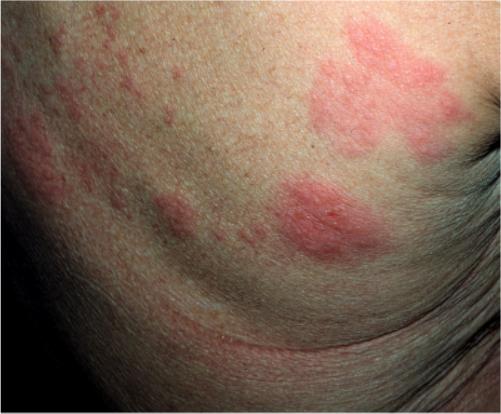Zoster
|
The presence of itchy or painful vesicles on an erythematous base in a dermatomal distribution should be considered Zoster (shingles) until proven otherwise. Use a Tzanck smear (see Herpes Simplex above) to confirm the diagnosis. Thoracic segments are the most frequently affected. The branches of the
trigeminal nerve are also frequently involved and can be quite
painful. The ophthalmic branch in particular is quite problematic.
For patients with cranial nerve V1 involvement, be sure to
ask about eye symptoms and do examine the eye. Keratoconjunctivitis
and/or iridocyclitis are potentially serious complications. Consult
with an ophthalmologist.
Treatment of Zoster is
threefold in nature: antiviral medications (if indicated), pain
relief, and drying of the vesicles. Acyclovir 800 mg orally five
times a day is helpful only if given with 48 hours of the onset of the
rash. The appropriate doses of valacyclovir and famcyclovir are 1000
mg TID and 500 mg TID respectively. The pain can be quite severe;
prescribe narcotics if required. The use of Burow's solution to
compress the vesicles (see Impetigo above) is soothing and will
desiccate the blisters. While the vesicular fluid of
zoster lesions is minimally contagious, this is usually not a problem
in immunocompetent patients. Patients can return to work with active
vesicles as long as the involved area is covered with clothing. Written and revised by CAPT Dennis
A. Vidmar, MC, USN, Department of Military and Emergency
Medicine, and Department of Dermatology, Uniformed Services University
of the Health Sciences, Bethesda, MD (1999). Additional images provided by CAPT Vidmar in
June, 2000, subsequent to the initial publication of this manual. |
Herpes Zoster |
Preface · Administrative Section · Clinical Section
The
General Medical Officer Manual , NAVMEDPUB 5134, January 1, 2000
Bureau
of Medicine and Surgery, Department of the Navy, 2300 E Street NW, Washington, D.C.,
20372-5300
This web version of The General Medical Officer Manual, NAVMEDPUB 5134 is provided by The Brookside Associates Medical Education Division. It contains original contents from the official US Navy version, but has been reformatted for web access and includes advertising and links that were not present in the original version. This web version has not been approved by the Department of the Navy or the Department of Defense. The presence of any advertising on these pages does not constitute an endorsement of that product or service by either the Department of Defense or the Brookside Associates. The Brookside Associates is a private organization, not affiliated with the United States Department of Defense. All material in this version is unclassified. This formatting © 2006 Medical Education Division, Brookside Associates, Ltd. All rights reserved.
Home · Textbooks and Manuals · Videos · Lectures · Distance Learning · Training · Operational Safety · Search
|
|
|
This website is dedicated to the development and dissemination of medical information that may be useful to those who practice Operational Medicine. This website is privately-held and not connected to any governmental agency. The views expressed here are those of the authors, and unless otherwise noted, do not necessarily reflect the views of
the Brookside Associates, Ltd., any governmental or private organizations. All writings, discussions, and publications on this website are unclassified.
© 2006 Medical Education Division, Brookside Associates, Ltd. All rights reserved
Other Brookside Products

